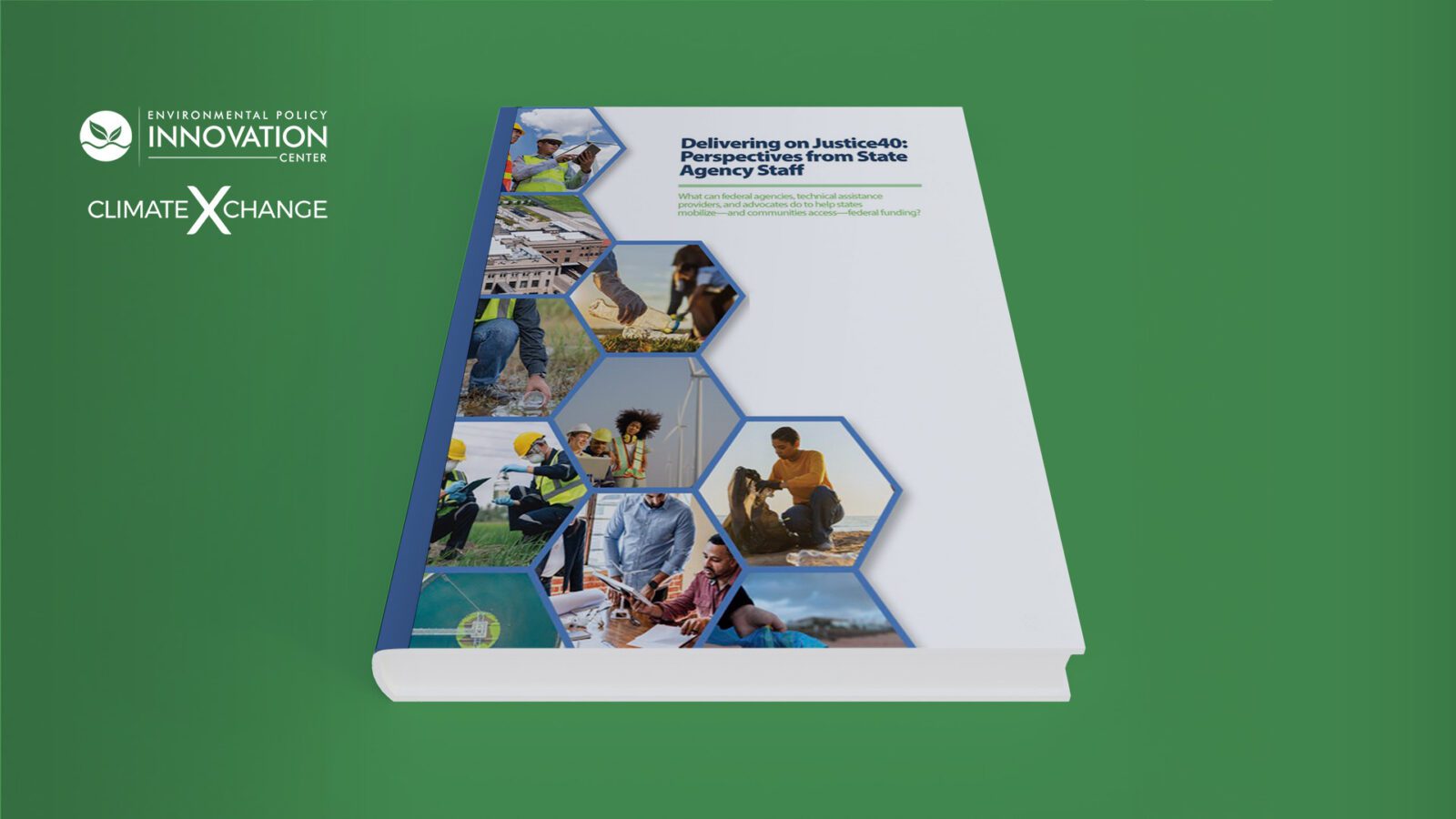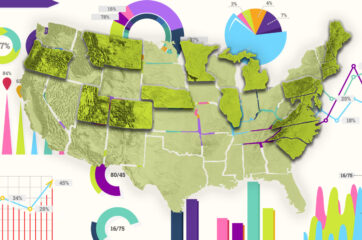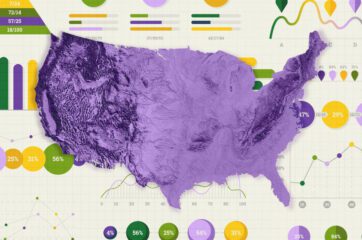Delivering on Justice40: Perspectives from State Agency Staff
This report surveys the barriers that state agency staff face when deploying federal climate and clean energy funds to priority communities. Based on interviews with 16 state agency managers of Justice40 covered programs, we find that states need: 1) streamlined and transparent federal guidance, 2) eased procurement requirements, 3) flexible use of community screening criteria, and 4) technical assistance in tracking and reporting benefits.
Communities need additional support to navigate federal funding opportunities, including technical assistance on applications and projects, long-term capacity building, and extended timelines for community engagement. All stakeholders are encouraged to facilitate direct connections across states to share best practices, convene mixed audiences of private and public actors, and convey process-oriented feedback to federal agencies to improve the Justice40 funding pipeline.
Watch Delivering on J40 authors talk about their research and answer questions about the report. Read a transcript of the participant Q&A here.
It’s been more than two years since the creation of the Justice40 Initiative, which established the goal that 40 percent of federal climate and clean energy investment benefits flow to communities long overburdened by pollution. While this is a crucial and unprecedented step toward prioritizing frontline communities, delivering on this promise will require more than the funding itself. We need robust collaboration and information-sharing across federal, tribal, state, and local governments, and among governmental staff, non-governmental organizations (NGOs), technical assistance (TA) providers, and policymakers. It will certainly take more than a village to ensure underserved communities can access and implement the solutions they need to secure a just and resilient future.
State agencies sit at the crossroads of this federal funding for communities — they administer and award federal formula funds, facilitate competitive grant applications, and coordinate stakeholder engagement and knowledge sharing. In order to shed light on how these important stakeholders are navigating federal guidelines, and to identify barriers to reaching the communities Justice40 was designed to serve, Climate XChange, Environmental Policy Innovation Center (EPIC), and Beech Hill Research spoke with 16 state agency staff working on Justice40-covered programs across the country in the spring and summer of 2023. Our goal was to understand the experiences of state agency staff and distill a snapshot of their work in their own words.
The overarching question we sought to answer: What is needed to meet the promise of Justice40?
The findings presented in this report represent input from the 16 staff we interviewed, who were deliberately selected to provide perspectives from within state governmental agencies; our findings should be understood within the context of these interviews, however illustrative the insights or suggestions of these state staff may be.
Findings: Barriers to Meeting Justice 40
In our interviews, we found that state staff are committed to reaching the communities prioritized by Justice40 but frequently run up against barriers. One interviewee offered this metaphor describing the what’s at the core of these challenges:
“We’re taking all of the funding and resources that those above us want us to give these communities, and we’re sealing it in a can, we’re handing them the can, but we’re not giving them a can opener. So they have the resources there, but they can’t access them.”
In this metaphor, the can is federal funding, and the can opener is the knowledge, experience, and capacity a community needs to successfully receive and implement climate and clean energy solutions. While experiences varied across interviews, we heard common themes about how overcoming barriers around communication, capacity, technical assistance, and data are needed to fulfill the goal of Justice40. Findings, which are described alongside almost 50 quotes from interviewees, are grouped into six themes:
1. Federal Guidance, Communication, and Support
State staff believe they are seeing the most critical federal guidelines, thanks to personal communications with federal agency and regional administrator staff. However, they fear they are missing details or opportunities in the overwhelming amount of information from government and NGO sectors alike. Additionally, the perception that more detailed guidance is coming can delay making and updating plans.
“It’s like a quilt, trying to meet all the [federal program] requirements out there.”
“EPA Region 5 has been really helpful with providing guidance so far—we talk almost weekly.”
2. State Staff Capacity Constraints and Related Needs
State staff are used to solving issues with constrained state resources. They have low but growing awareness of federal and NGO assistance and are open to outside help, if it’s packaged succinctly. Still, they are wary of the procurement and contracting process to secure these services.
“One thing that’s hard to do from a capacity standpoint is how to even let people help us. We know there’s a technical assistance source, and we vaguely know what they’ve done for other states, but how exactly can we coordinate or leverage that resource? I don’t feel I have time for that.”
3. Reaching Underserved Communities: Outreach, “Circuit Riders,” and “Navigators”
Funding existing local stakeholders (termed “circuit riders” and “navigators” by interviewees) to connect communities with programs is critical for reaching low-capacity and historically underserved applicants, who may have weaker or nonexistent relationships with state staff and community-based organizations (CBOs). State staff want federal programs to enable—and other parties to facilitate—paid partnerships and contracts with local entities.
“With engagement, the messenger matters, where you show up matters; we have some connections and relationships we’ll be using, but we haven’t made all the relationships we need, we’re not in all the spaces we need to be.”
4. Funding Underserved Communities: Application Assistance and End-to-End Support
Nearly all interviewees were concerned about smaller and lower-capacity communities finding resources (and networks) to plan and apply for funds. Lower-capacity and historically underserved communities need long-term capacity-building support, in addition to grant and application assistance, which is also a long-standing critical barrier. Connecting these communities with providers (e.g., TA or engineers) can take longer than application timelines.
“EPA people have big grand ideas, but these communities and organizations are literally three people who meet up on the weekends.”
“Local community leaders have ideas for projects but don’t have technical capacity to make it happen—it’s so much more than grant-writing assistance.”
5. Use of Environmental Justice (EJ) and Disadvantaged Community (DAC) Screening Tools
Nearly all interviewees were concerned about smaller and lower-capacity communities finding resources (and networks) to plan and apply for funds. Lower-capacity and historically underserved communities need long-term capacity-building support, in addition to grant and application assistance, which is also a long-standing critical barrier. Connecting these communities with providers (e.g., TA or engineers) can take longer than application timelines.
“EPA people have big grand ideas, but these communities and organizations are literally three people who meet up on the weekends.”
“Local community leaders have ideas for projects but don’t have technical capacity to make it happen—it’s so much more than grant-writing assistance.”
6. Tracking and Reporting Toward Equity and Justice40 Goals
State staff believe their programs are able to meet the quantitative goals* of Justice40. However, with the exception of State Revolving Funds (SRFs), interviewees have limited tracking or dashboards and few have started thinking about data collection or reporting on these goals.
“State agency staff need technical assistance…related to tracking and reporting benefits, defining benefits, et cetera. This is currently an unmet need.”
*Justice40’s quantitative goal is that 40 percent of the “overall benefits of certain Federal investments” — those related to combating climate change and prioritizing EJ — flow to disadvantaged communities that have been historically marginalized, underserved, and overburdened by pollution. Qualitatively, Justice40 also directs administrators of “covered programs” to conduct meaningful engagement with stakeholders to ensure community members have an opportunity to provide input on program decisions.
Recommendations: How to Support States and Communities
Our detailed Recommendations and Considerations section contains targeted ideas and recommendations from our interviews for three stakeholders groups to consider:
- Federal Program, Implementation, and Oversight Staff: Federal staff and program officers across agencies and regional offices, who establish criteria, oversee programs, and coordinate state agency staff (among other administrators or applicants).
- Technical Assistance (TA) Providers: Organizations or individuals who provide direct assistance, capacity-building, or general support to federal funding applicants or administrators, whether for state agency staff, local communities, or Tribal Nations or entities.
- Policymakers, Legislators, and Advocates: Elected officials, policy experts, and legislative staff at both state and federal levels, as well as advocates and organizations working to influence policy, program design, and implementation related to Justice40.
Our recommendations are all from the perspective of state staff we interviewed. We recognize that other stakeholders and applicants, including municipal leaders and CBOs in underserved communities, may have different recommendations and priorities. Further, we recognize that many of these recommendations may be addressed or underway, though there may be gaps in communication or delivery of new programs or services.
Overall, state staff we interviewed do not expect federal agencies to solve every problem, and they are highly empathetic to capacity constraints across the field of stakeholders. Many of the suggestions we heard from state staff were aimed at providing critical outreach and support to lower-capacity communities and applicants, and making the most of their own office’s capacity to navigate program guidelines and connect communities with resources.
State staff identified several cross-cutting needs that could be addressed by governmental and non-governmental stakeholders — and in fact are only possible with collaboration across federal, state and local actors, and across governmental and NGO actors:
1. Make connections, not just communications.
With the deluge of written materials and webinars from government and NGOs alike, state staff rely on personal communications. All stakeholders should prioritize personal introductions and collaborative events for applicants (state and local alike) to learn about or share approaches. Make points-of-contact visible and accessible for those navigating a federal, state, or TA process for the first time.
2. Convene mixed audiences for workshops and events.
Information-sharing across states and regions, governmental and non-governmental sectors, and federal-to-local levels is critical to disseminating best practices, as well as making connections between parallel agency staff across states for deduplication of efforts and faster, smoother action. Where possible, try to mix audiences and presenters.
3. Rapidly expand and fund local actors as “circuit riders” and “funding navigators.”
Build on existing community relationships and trust through a mix of models and funding streams, including but not limited to building these models into federal program design and funding, identifying federal and NGO TA funding for these positions, and enabling state or local entities to contract with local actors, whether through easing procurement and contracting requirements or otherwise.
4. Ease contracting and procurement barriers for technical assistance.
Uncertainty about contracting processes for federal, NGO, consultant, and engineering support creates hesitancy around pursuing new forms of TA among state staff we interviewed and, in their opinion, local applicants. When presenting services, clarify contracting or fees upfront, and continue working with federal and state legislators and procurement staff to ease barriers.
5. Model open feedback and push for process-oriented change.
This is the time to adapt program design and funding structures where needed, and while state staff seem comfortable asking clarifying questions, they don’t often push for process changes (e.g., on application burdens, reporting requirements, program timelines). This requires not only those “above” asking and providing options for feedback, but those “below” sharing what they see or need. Try to break “waterfall”-style communications (information flowing down from federal to state to local actors) by purposefully asking for (and giving) feedback.
Conclusion
From our interviews, we found that meeting Justice40’s goals requires more than deploying money and technology to priority communities. It requires rethinking how we communicate as a national network of climate stakeholders, creating robust and meaningful relationships with existing local stakeholders, and building long-term capacity in small and underserved communities.









